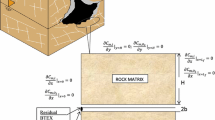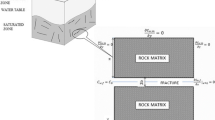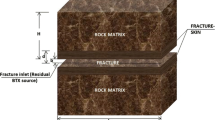Abstract
Colloid occurrence is a crucial factor influencing the movement of hydrophobic components like petroleum hydrocarbons in fractured aquifers. In this study, an attempt is made to examine the influence of colloids on the movement of Benzene, Toluene, Ethylbenzene, and Xylene (BTEX) in a saturated fractured rock aquifer. A numerical model is developed to simulate the colloid-BTEX co-transport in a fracture-matrix system (F-M-S). The modeling investigation is performed by adopting the dual-porosity modeling approximation for the fractured aquifer. The study's outcome suggests that the colloid influence is more on the transport of less soluble BTEX components: ethylbenzene and xylene. The colloid presence does not influence the Benzene (component with the highest pure phase solubility) movement in F-M-S. The impact of various colloid parameters such as velocity, inlet concentration, filtration rate at fracture-matrix interface, attachment rate on the fracture surface, on BTEX transport in fracture and matrix, is estimated. Migration of Toluene, Ethylbenzene, and Xylene (TEX) in fracture and matrix is turned out to be sensitive to these parameters. The peak dissolved concentration and the peak location of these components are found to be sensitive to these parameters. The colloid impact on the dissolved concentration levels of TEX is more evident in the later simulation stages.



source zone (Cf0) at fracture inlet (left fracture boundary)






Similar content being viewed by others
Abbreviations
- b :
-
Half fracture thickness [L]
- \({C}_{\text{cf}}\) :
-
Suspended colloid concentration in fracture [ML−3]
- \({C}_{\text{cm}}\) :
-
Suspended colloid concentration in the matrix [ML−3]
- \({C}_{\text{f}}^{i}\) :
-
Dissolved BTEX concentration in fracture [ML−3]
- \({C}_{\text{m}}^{i}\) :
-
Dissolved BTEX concentration in matrix [ML−3]
- \({D}_{\text{cm},y}\) :
-
Diffusion coefficient of colloids in matrix [L2T−1]
- \({D}_{\text{f}}^{i}\) :
-
Dispersion coefficient of BTEX in fracture [L2T−1]
- \({D}_{\text{m}}^{i}\) :
-
Diffusion coefficient of BTEX in matrix [L2T−1]
- \({\varepsilon }_{\text{f}}\) :
-
Colloid attachment on Fracture surface [L−1]
- \({f}_{\text{C}}\) :
-
Colloid filtration rate at the interface [−]
- \(H\) :
-
Distance from fracture center line to half matrix width [L]
- \(i\) :
-
Index of BTEX component [−]
- \({k}_{\text{f}}^{i}\) :
-
Kinetic attachment BTEX on fracture wall [T−1]
- \({k}_{\text{f,mc}}^{i}\) :
-
Kinetic attachment of BTEX on mobile colloids in fracture [T−1]
- \({k}_{\text{f,ic}}^{i}\) :
-
Kinetic attachment of BTEX on immobile colloids in fracture [T−1]
- \({K}_{\text{f}}^{i}\) :
-
Distribution coefficient of BTEX on fracture wall [L3M−1]
- \({K}_{\text{f,mc}}^{i}\) :
-
Distribution coefficients of BTEX on mobile colloids in fracture [L3M−1]
- \({K}_{\text{f,ic}}^{i}\) :
-
Distribution coefficients of BTEX on immobile colloids in fracture [L3M−1]
- \({k}_{\text{m}}^{i}\) :
-
Kinetic attachment of BTEX on matrix grains [T−1]
- \({k}_{\text{m,mc}}^{i}\) :
-
Kinetic attachment of BTEX on mobile colloids in matrix [T−1]
- \({k}_{\text{m,ic}}^{i}\) :
-
Kinetic attachment of BTEX on immobile colloids in matrix [T−1]
- \({K}_{\text{m}}^{i}\) :
-
Distribution coefficient of BTEX on matrix grains [L3M−1]
- \({K}_{\text{m,mc}}^{i}\) :
-
Distribution coefficients of BTEX on mobile colloids in matrix [L3M−1]
- \({K}_{\text{m,ic}}^{i}\) :
-
Distribution coefficients of BTEX on immobile colloids in matrix [L3M−1]
- \({kd}_{\text{cm}}\) :
-
Kinetic attachment rate of colloids on matrix grains [T−1]
- \({Kd}_{\text{cm}}\) :
-
Distribution coefficient of mobile colloids in matrix [L3M−1]
- \(L\) :
-
Fracture length [L]
- \({MF}^{i}(t)\) :
-
Mole fraction of the BTEX component at time
- \({\rho }_{\text{m}}\) :
-
Matrix density [ML−3]
- \({R}_{\text{r,f}}\) :
-
Remobilization rate of colloid in fracture [T−1]
- \({R}_{\text{r,m}}\) :
-
Remobilization rate of colloid in the matrix [T−1]
- \({S}^{i}\) :
-
Pure phase solubility of BTEX [ML−3]
- \({S}_{\text{cf}}\) :
-
Colloid concentration attached on fracture surface [ML−3]
- \({S}_{\text{cm}}\) :
-
Sorbed colloid concentration on matrix grains [ML−3]
- \({S}_{\text{f}}^{i}\) :
-
BTEX concentration attached on fracture walls [ML−3]
- \({S}_{\text{f,ic}}^{i}\) :
-
BTEX concentration attached on immobile colloids in fracture [ML−3]
- \({S}_{\text{f,mc}}^{i}\) :
-
BTEX concentration attached on mobile colloids in fracture [ML−3]
- \({S}_{\text{m}}^{i}\) :
-
BTEX concentration attached on matrix grains [ML−3]
- \({S}_{\text{m,ic}}^{i}\) :
-
BTEX concentration attached on immobile colloids in matrix [ML−3]
- \({S}_{\text{m,mc}}^{i}\) :
-
BTEX concentration attached on mobile colloids in matrix [ML−3]
- t :
-
Temporal variable [T]
- θ m :
-
Matrix porosity [−]
- v:
-
Groundwater flow velocity [LT−1]
- \({V}_{\text{cf}}\) :
-
Fracture colloid velocity [LT−1]
References
Abdel-Salam A, Chrysikopoulos CV (1994) Analytical solutions for one-dimensional colloid transport in saturated fractures. Adv Water Resour 17(5):283–296
Chopra M, Sunny F, Oza RB (2016) Numerical modeling of colloid-facilitated radionuclide decay chain transport in a coupled fracture–matrix system. Environ Earth Sci 75:1300
Chrysikopoulos C (1994) Analytical solution for one-dimensional colloid transport in saturated fractures. Adv Water Resour 17:283–296
Grolimund D, Borkovec M, Barmettler K, Sticher H (1996) Colloid-facilitated transport of strongly sorbing contaminants in natural porous media: a laboratory column study. Environ Sci Technol 30(10):3118–3123
Hansen SK, Kueper BH (2014) A new model for coupled multi-component NAPL dissolution and aqueous-phase transport, with application to creosote dissolution in discrete fractures. Water Resour Res 50:58–70
Ibaraki M, Sudicky EA (1995a) Colloid-facilitated contaminant transport in discretely fractured porous media 1. Numerical formulation and sensitivity analysis. Water Resour Res 31(12):2945–2960
Ibaraki M, Sudicky EA (1995b) Colloid-facilitated contaminant transport in discretely fractured porous media 2. Fracture network examples. Water Resour Res 31(12):2961–2969
Kalhor K, Ghasemizadeh R, Rajic L, Alshawabkeh A (2019) Assessment of groundwater quality and remediation in karst aquifers: a review. Groundw Sustain Dev 8:104–121
Kao CM, Huang WY, Chang LJ, Chen TY, Chien HY, Hou F (2006) Application of monitored natural attenuation to remediate a petroleum-hydrocarbon spill site. Water Sci Technol 53(2):321–328
Kogel-Knabner I, Totsche KU (1998) Influence of dissolved and colloidal phase humic substances on the transport of hydrophobic organic contaminants in soils. Phys Chem Earth 23(2):179–185
Kumar GS (2014) Mathematical modelling on transport of petroleum hydrocarbons in saturated fractured rocks. Sadhana 39(5):1119–1139
Magaritz M, Amiel AJ, Ronen D, Wells MC (1990) Distribution of metals in a polluted aquifer: a comparison of aquifer suspended material to fine sediments of the adjacent environment. J Contam Hydrol 5(4):333–347
Marley NA, Gaffney JS, Orlandini KA, Cunningham MM (1993) Evidence for radionuclide transport and mobilization in a shallow, sandy aquifer. Environ Sci Technol 27:2456
Molnar IL, Johnson WP, Gerhard JI, Willson CS, O’Carroll DM (2015) Predicting colloid transport through saturated porous media: a critical review. Water Resour Res 51:6804–6845. https://doi.org/10.1002/2015WR017318
Mori WR, Alexander H, Geckeis W, Hauser T, Schafer J, Eikenberg, et al (2003) The colloid and radionuclide retardation experiment at the Grimsel Test Site: influence of bentonite colloids on radionuclide migration in a fractured rock. Colloids Surf A 217:33
Natarajan N, Kumar GS (2011) Numerical modeling of bacteria facilitated contaminant transport in fractured porous media. Colloids Surface A 387:104–112
Natarajan N, Kumar GS (2012) Evolution of fracture permeability due to co-colloidal bacterial transport in a coupled fracture-skin-matrix system. Geosci Front 3:503–514
Reiche T, Noseck U, Schäfer T (2016) Migration of contaminants in fractured-porous media in the presence of colloids: effects of kinetic interactions. Transp Porous Med 111:143–170
Renu V, Kumar GS (2018a) Mathematical modeling on mobility and spreading of BTEX in a discretely fractured aquifer system under the coupled effect of dissolution, sorption, and biodegradation. Transp Porous Med 123(2):421–452
Renu V, Kumar GS (2018b) Multispecies transport modeling on biodegradation of Benzene, Toluene and Xylene in a saturated fracture-matrix system with multiple electron acceptors. Environ Eng Sci 35(10):1096–1108
Renu V, Kumar GS (2019) Co-colloidal BTEX and microbial transport in a saturated porous system: numerical modeling and sensitivity analysis. Transp Porous Med 127(2):269–294
Saiers JE, Hornberger GM (1996) The role of colloidal kaolinite in the transport of cesium through laboratory sand columns. Water Resour Res 32:33–41
Sen TK, Mahajan SP, Khilar KC (2002) Colloid-Associated contaminant transport in porous media: 1. Experimental Studies. Aiche J 48:2366–2374
Villholth KG (1999) Colloid characterization and colloidal phase partitioning of polycyclic aromatic hydrocarbons in two creosote-contaminated aquifers in denmark. Environ Sci Technol 33:691
Williams SD, Ladd DE, Farmer JJ (2006) Fate and transport of petroleum hydrocarbons in soil and groundwater at big south fork National River and recreation area, Tennessee and Kentucky, 2002–2003, U.S. Geological Survey Scientific Investigations Report 2005–5104
Wolfsberg A, Dai Z, Zhu L, Reimus P, Xiao T, Ware D (2017) Colloid-facilitated plutonium transport in fractured tuffaceous rock. Environ Sci Technol 51(10):5582–6559
Zhang W, Tang X, Weisbrod N, Guan Z (2012) A review of colloid transport in fractured rocks. J Mount Sci 9(6):770–787
Zhou RJ, Zhan HB (2017) Reactive solute transport in an asymmetrical fracture-rock matrix system. Adv Water Resour 112:224–234
Zvikelsky O, Weisbrod N (2006) Impact of particle size on colloid transport in discrete fractures. Water Resour Res 42:W12S08
Funding
Not applicable.
Author information
Authors and Affiliations
Corresponding author
Ethics declarations
Conflict of interest
The authors declare that there are no conflicts of interest regarding the publication of this manuscript.
Additional information
Publisher's Note
Springer Nature remains neutral with regard to jurisdictional claims in published maps and institutional affiliations.
Supplementary Information
Below is the link to the electronic supplementary material.
Rights and permissions
About this article
Cite this article
Valsala, R., Govindarajan, S.K. Numerical modeling of colloid-assisted BTEX transport in a saturated fractured aquifer. Environ Earth Sci 81, 37 (2022). https://doi.org/10.1007/s12665-021-10161-3
Received:
Accepted:
Published:
DOI: https://doi.org/10.1007/s12665-021-10161-3




